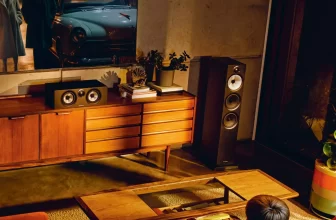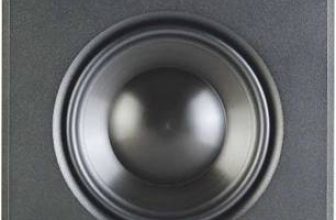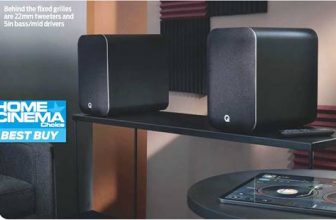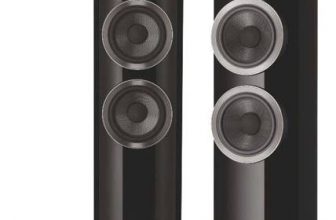Piega Premium Wireless 701 Review – Tubular belles
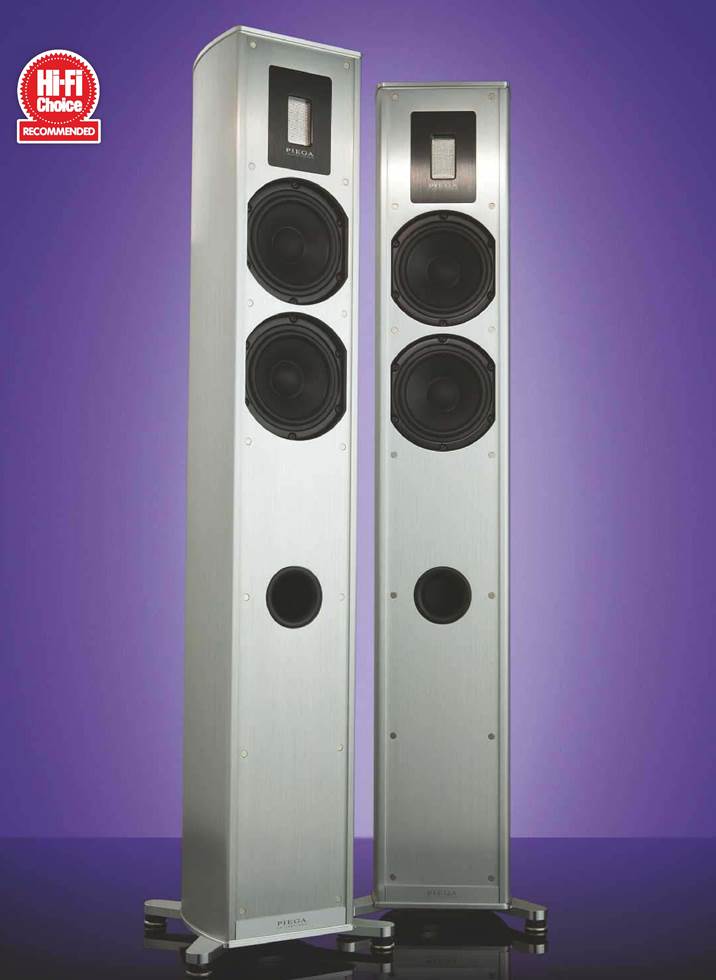
An elegant exterior can hide a multitude of sins but, as David Vivian discovers, this floorstander sounds as good as it looks. Read our Piega Premium Wireless 701 Review.
Table of Contents

Piega’s Premium Wireless 701 is precisely the kind of speaker glossy magazine lifestyle supplements exist for. A willowy tower of gleaming aluminium, it’s so good looking it isn’t just decor friendly but puts pressure on its surroundings to come up to par. The aluminium outriggers at its base (optionally spiked or pad-footed) aren’t just functional, but fastidiously engineered and exquisitely finished. Even the act of attaching them is a pleasurably tactile experience rather than a tedious necessity. The £ price tag might be lower foothills high-end, but the quality of execution is as rarefied as it comes.
A fully active design, there’s no need for untidy external amplifiers and speaker cables and the mains leads trailing from the back of each speaker
First impressions are of clarity and control, detail and dynamics, timing and tempo
are slim enough to be tucked out of sight. The same is true of the elegantly compact Piega Connect box, which provides the wireless connection between whatever source you plug into it and the speaker. It doesn’t have to be part of a ‘hi-fi display’ but, physical interconnects permitting, can be hidden away in a cupboard. And, for people who can’t be bothered with wires at all, streaming music, via aptX Bluetooth, from a smartphone or tablet, is the simplest option of all.
In short, the Piega Premium Wireless 701 ticks all the modern, on-trend boxes and for your average glossy lifestyle supplement that’s by and large where the story ends, the assumption being that hard-bitten audiophiles seeking the very best in sound quality are willing to live with an unholy mish-mash of components and wouldn’t have started reading in the first place. As misconceptions go, that would be a sizeable whopper.
Yes, brushed aluminium looks cool and wireless is very much of the moment, but when Leo Greiner and Kurt D Scheuch started Piega in Horgen, on the banks of Lake Zurich, in 1986, it was all about the sound and according to Greiner’s son Manuel – now running things – it still is.
How low can you go?
The company name gives a strong hint. Piega is Italian for ‘fold’, and it was a new type of folded ribbon tweeter – the so-called Linear Drive Ribbon – that gave the fledgling Swiss operation a significant slice of its USP and, over time, evolved into what is claimed to be “the world’s first coaxial ribbon system”. The practical upshot is that Piega’s large ribbon panel reaches down far lower than conventional ribbon tweeters, allowing much easier integration with the partnering dynamic drivers, which can be freed to do what they do best (bass and lower midrange).
What seems particularly Swiss, however, is the hours of intricate, painstaking labour poured into making every ribbon. The work is so precise and exacting, it can only be carried out in a room with carefully maintained climatic conditions at Piega’s factory in Horgen. Maybe it’s just as well that most of the employees’ eyes fall on a tranquil Lake Zurich when they look out of the window. Both the factory and a second studio building have lakeside locations.
The management believes that this is how it should be; where the staff feel at their best, where creativity is encouraged and where the view across the water has a calming effect even when things get hectic.
The other strand of the company’s USP is the use of aluminium for the cabinets of its more up-market models. As already discussed, the
DETAILS
Piega Premium Wireless 701
ORIGIN Switzerland
TYPE 2.5-way floorstanding wireless active loudspeaker
WEIGHT 28kg
DIMENSIONS (WxHxD) 180 x1,060 x230mm
FEATURES
• 1x LDR 3056 ribbon tweeter
• 2x 140mm MDS mid/bass drivers
• Quoted power output: 200W Class D
DISTRIBUTOR Piega Loudspeakers (UK) Ltd.
TELEPHONE +41 44 725 9042
WEBSITE piega.co.uk
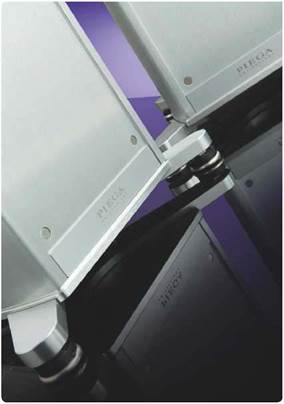
The robust outriggers on the base can be spiked or pad-footed
aesthetic is very appealing, but in conjunction with the seamlessly curved boat-tail profile of the cabinet, aluminium also delivers exceptional rigidity to put the bite on resonance and distortion. All right, form follows function, but clearly Piega is going for the win-win here. Once more employing the talents of Swiss designer Stephen Hurlemann to finesse his original ‘look’ for the Premium series by flush-fitting the grilles is kind of a giveaway.
Developed from Piega’s existing passive Premium range of speakers, the active Wireless lineup likewise consists of just three models: the 301 standmount, the smaller floorstanding 501 and the 701 floorstanding 2.5-way flagship I’m reviewing here. As each model has an RCA analogue input on its back panel, it’s possible to use it as a wired active speaker fed from a conventional preamp with sources connected or digital device toting a variable output. But if you want to go wireless, you’ll need the Connect interface (see boxout overleaf).
Although aluminium is a lightweight alloy, the combination of the 701’s lofty enclosure and 200W of onboard Class D amplification make for a structure that belies its svelte frame by tipping the scales at 28kg, though thankfully the slim and curved alloy form is easy enough to grasp and manoeuvre into position.
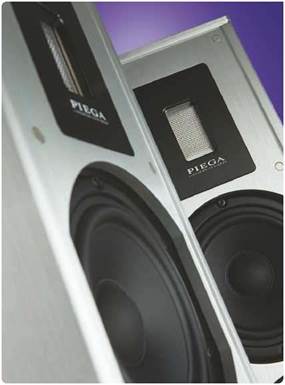
The latest iteration of the LDR ribbon tweeter for the 701 is called the 3056 and features a tweaked magnet system and new foil membrane to provide a wider frequency response (all the way to 35kHz is claimed) as well as improved efficiency. It’s joined by two long-throw 140mm MDS drivers handling the lower-mid and bass frequencies which, with the help of a front-firing reflex port, reach down to a claimed 34Hz.
Round the back of each enclosure, near floor level, is a control panel with tiny toggle switches. The one labelled Group has three positions (red, white and blue) and allows you to link pairs of wireless Piegas for multi-room installations. Only ‘red’ supports 24-bit/96kHz hi-res audio; white and blue are restricted to 24-bit/48kHz. The rest of the tiny switchgear is used to ‘hand’ the speakers – left and right – and configure them – with DSP – for an open-space setting, close to a back wall or near a corner. DSP also automatically adjusts each speaker’s frequency balance according to volume. At a low setting, bass and treble are subtly boosted while, with something closer to party levels, the bass is gently reined in to prevent driver overload and irate neighbours banging at your front door.
Take your pick: purist wired active speaker or wireless wonder with multi-room compatibility. I start with
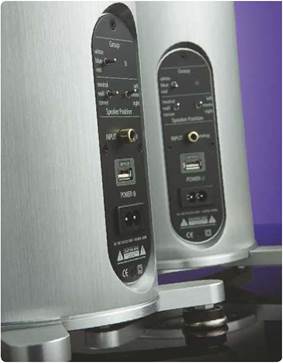
Inclusion of an RCA analogue input means it can operate as a wired active loudspeaker
pure and simple, not least because it will almost certainly be the shortest route to the Piega’s best sound. An Audiolab 6000 CDT CD transport (HFC 447) and Cambridge Audio CXN V2 network music player (HFC 437) are connected to Chord Electronics’ Hugo 2 DAC/preamp (HFC 428) and, from there, the signal is fed directly to the speaker’s RCA inputs via lengthy runs of Nordost Hemidall 2 interconnect. Naturally, I’m using the Hugo’s digital volume control to adjust system level.
Sound quality
Wires, yes, and only digital sources but given the talent of the front end it makes for a simple, elegant and deliciously potent system – the only problem being that the wireless capability that you’ve paid for is redundant in this configuration. That said, the sonic pay off is considerable and once again a big endorsement for the active way of doing things.
I feel the best way to kick off a session with a speaker as shiny and skinny as this is with a dose of grime, volume up. Stormzy’s Rainfall from Heavy Is The Head fits the bill splendidly and immediately reveals the kind of discipline that this rare marriage of individually amplified drivers, size-zero baffles and super-stiff metal enclosures can achieve. My first impressions are of classic hi-fi qualities that shine right into the listening room: clarity and control, detail and dynamics, timing and tempo. Bouncing affectingly over a massively thumping grime beat, Stormzy’s repeated “Fall on my enemies” refrain has fine intelligibility and separation, while the rhythmic detonation of bloated bass bombs registers both viscerally in the gut and has some semblance of definition and shape at ear-level. Everything considered, this is exactly what you want from a high-performance speaker system. Indeed, the sheer scale, solidity and heft of the sound is confoundingly at odds with the dainty footprint and slender form factor of the loudspeaker cabinet.
Going wireless with the Piega Connect box (and using its built-in DAC rather than the Chord) perhaps inevitably robs the sound of some immediacy and resolving power (and takes a further quality hit when streaming with Bluetooth), but the slightly softer and warmer presentation – while less hardcore audiophilic – retains a good measure of the wired setup’s precise, organised and punctual character, underpinned
If you want to go wireless, you’ll need to invest in the Connect interface
by a reassuring sense of coherence and imaging focus. Enough, certainly, to appreciate the inclusion of a Rega Planar 6 turntable with Ania MC cartridge (HFC 453) and Chord Electronics’ Huei phono stage – see p56. There’s plenty going on with Beverley Knight’s BK25 outing with the Leo Green Orchestra at the Royal Festival Hall on vinyl, especially the frenetic opener Made It Back. It’s not the greatest recording, but taking its cue from the Rega/Huei combo, the 701 doesn’t labour that but instead expertly mines passion and emotion from Knight’s soulful vocal while portraying the orchestral backing with effortless zeal and crisply defined timbral contrasts.
Randy Newman confirms it. I play The Great Debate from his terrific Dark Matter album and the result is attitude on steroids, but delivered with compelling detail, warmth and texture. Apart from its effortless ability to fill a big room with high-definition sound and almost preposterously full and deep bass given the apparent volume of the enclosure, the Premium Wireless 701’s musical skills span the whole spectrum from get-up-and-dance verve and energy to draw-you-right-in emotional power and subtlety.
Insight
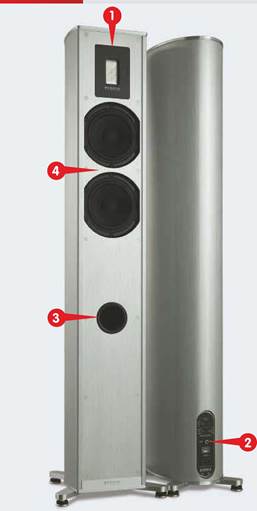
1 LDR 3056 ribbon tweeter
2 Single RCA analogue input
3 Forward-firing bass port
4 140mm MDS mid/bass drivers
wireless days
Piega’s wireless system works independently of a home wi-fi network.
The Connect box serves as an interface between the wireless speaker and existing hi-fi components or a multi-room system. Besides the lossless transmission of the source signal to the speaker, it offers stereo RCA analogue, digital optical and coaxial inputs along with a stereo analogue output for a speaker, subwoofer or amplifier. The USB port is for software updates only and there’s a small switch that allows you to toggle between a fixed or variable volume level. Which you choose will entirely depend on the connected source.
The Group settings correspond with those on the speaker’s control panel and there’s a choice of three wireless frequency bands used to communicate with the speaker. Finally, the aptX Bluetooth module lets you play music directly from a phone, tablet or laptop. Volume and Bluetooth pairing buttons are located on top of the box.
Conclusion
Without wishing to demean the many fine, high value compact desktop and standmount active wireless systems that are currently on sale, Piega’s Premium Wireless 701 takes things to the next level. The best part of £ (including the Connect wireless interface) is no small investment, but then – arguably – this loudspeaker’s style, build and finish is a match for anything claiming a loftier high-end billing at many times the price. Given an appropriately talented source and the option it offers to be wired, its sound isn’t far behind
OUR VERDICT
HOW IT COMPARES
For many, KEF’s LS50 Wireless standmount (HFC 433) hits a rewarding price/ performance sweet spot while B&W’s Formation Duo (HFC 453) makes a strong case for spending a little more and, in terms of wireless sound quality, runs the Piega pretty close. Use the 701 as a wired active speaker, and the gap widens, prompting comparison with ATC’s wonderful SCM19AT, which sounds more powerful and dynamic but can’t compete with the Swiss design’s supermodel looks.
Q&A
Dominik Zuger
Research & development, Piega Premium Wireless

DV: Is aluminium a better material acoustically for speaker enclosures?
DZ: We pioneered aluminium cabinets over 25 years ago in order to create acoustically ideal shaped cabinets, with super-rigid enclosures, that maximise internal volume through much narrower wall thickness than equivalent MDF. Aluminium has to be strategically damped to eliminate resonances in the audio spectrum so we developed our own bespoke damping material that is applied to the inside of the cabinet by hand, giving Premium Wireless cabinets better acoustic performance and larger internal volume than similarly sized MDF cabinets. This has allowed us to create slimmer, more elegant loudspeakers with a narrow footprint.
Why did you go for Bluetooth instead of wi-fi wireless networkstreaming?
It was a tactical decision to ensure Premium Wireless was not tied-in to any one streaming ecosystem and ensure it can be used with any existing audiophile sources. We understand audiophiles want premium-quality sound that can only come from a dedicated audiophile streamer. Using a hi-res streamer from quality brands like Naim or Bluesound, hardwired to the Piega Connect unit and streamed losslessly to the Premium Wireless gives the best performance and allows wireless loudspeaker convenience to be added to any existing audiophile sound system.
How did you design the amplification and DSP for the active 701?
The custom electronic topology starts with an extremely low-noise switch mode power supply and two or three individual amplifier stages, depending on the model. We use a very linear audiophile-quality Class D amplifier design, with a separate amplifier for each driver. The flagship Premium Wireless 701 has three individual amplifiers, conservatively rated at a total of 200W RMS for each loudspeaker. Crossover, amplifier control and DSP are handled by top- tier Analog Devices hardware, with our own custom programming.


